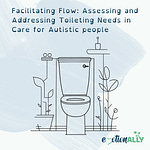There are numerous steps and considerations in the process of being appropriately clothed under the legislation.
When considering clothing needs we need to consider sensory differences. Particular areas to investigate may include acute sensitivity to textures commonly tags, seams, rough fabrics (e.g., wool, denim), stiff materials, and even the feeling of fabric against the skin can be perceived as irritating, painful, or overwhelming. This can lead to a strong aversion to certain clothes or a need to remove them. Clothing that is too tight, too loose, or has elastic bands can be highly uncomfortable. Some may prefer very tight clothing for deep pressure input, while others find it unbearable.
Difficulty regulating body temperature means some clothes might feel too hot or too cold, leading to discomfort regardless of the actual temperature. They may not notice if they are appropriately dressed for the weather and temperature which can risk heatstroke or hypothermia in extreme weather.
Strong scents from detergents, fabric softeners, or even the smell of new clothes can be overwhelming and cause distress.
Some autistic people may be less aware of how their clothes feel or if they are twisted, dirty, or ill-fitting. They might not notice if their clothes are wet, stained, or if they have body odour, which can lead to social difficulties and hygiene issues.
Reduced body awareness can make it harder to feel how clothes are sitting on the body or to coordinate movements for dressing.
Dressing involves multiple steps in a specific order (e.g., underwear, socks, trousers, shirt). Autistic individuals may struggle with breaking down this task, remembering the sequence, or initiating each step. Keeping clothes organized, knowing where clean clothes are, or putting laundry away can be difficult.
Many autistic people have co-occurring dyspraxia, which affects fine and gross motor skills. This can make tasks like buttoning, zipping, tying shoelaces, or even pulling clothes over their head very challenging and frustrating.
Some autistic individuals may have less inherent concern about social norms or what others think about their appearance. While this isn't universally true, it can sometimes mean that the motivation to dress "appropriately" for social situations is lower if it conflicts with their sensory or comfort needs.
Chronic constipation or diarrhoea can lead to discomfort, fear of accidents, and a need for frequent clothing changes, adding to the burden.
Hypermobility/Ehlers-Danlos Syndromes can cause painful or overly flexible joints, making it difficult to manipulate clothing or maintain balance during dressing.
When an autistic person is experiencing burnout, their capacity to manage any demand, including dressing, can significantly decrease.
The process of being appropriately dressed
1. It will be important to triangulate your observations with the service users answers to these questions. They may say they are able to identify clean clothing but be wearing soiled clothes.
2. Can you wash and launder clothing? This involves identifying dirty clothing, using the washing machine, considering if the clothes are appropriately sorted, drying laundry and putting it away afterwards.
3. Can you dress appropriately for temperature and weather? Do you know when you feel hot, old or comfortable? Do you wear layers? What do you wear if it’s raining, snowing, sunny, etc.? how do you deal with changes in weather or temperature?
4. Can you dress appropriately for occasion? For example, what is the expected dress code for a job interview? What would you wear? What about a wedding?
5. Can you tell the difference between clean and dirty clothing? How do you do this (smell, appearance, where the clothes are placed, worn for a specific duration)?
6. Can you select undamaged clothing? Do you notice tears, holes, frayed edges, missing buttons, broken zippers, undone seams? What level of damage would make clothing unacceptable to wear? Is it a small hole in a sock or jeans with the crotch missing?
7. Can you fasten buttons independently?
8. Can you fasten shoelaces independently?
9. Do you need help dressing or undressing? It may help to ask what order they put clothing on, if they need prompts and if there is a requirement for correction what do they do. For example, if you realise your shirt is on backwards what do you do?
Remember
As a general guideline a need in being appropriately clothed will meet the threshold for provision of care if it impacts the following.
• Personal dignity: wearing soiled or ill-fitting clothes impacts how others perceive and interact with them. Whether this is moral or not it is something that is unfortunately true in current society.
• Physical and mental health and emotional wellbeing: risk of illness due to inadequate protection from weather, skin integrity issues from prolonged contact with soiled clothes, injuries from falls during dressing, or poor hygiene. Embarrassment, anxiety, depression, or social isolation due to difficulties with dressing appropriately or maintaining appearance.
• Participation in work, education, training, or recreation: being unable to dress “appropriately” for these activities can prevent engagement, leading to social exclusion and loss of purpose. It may be that support around reasonable adjustments at work is required.
• Suitability of living accommodation: if the home environment doesn't allow for safe dressing (e.g., no accessible space, poor lighting, lack of running water or washing facilities)
what can be done to support
.














Share this post